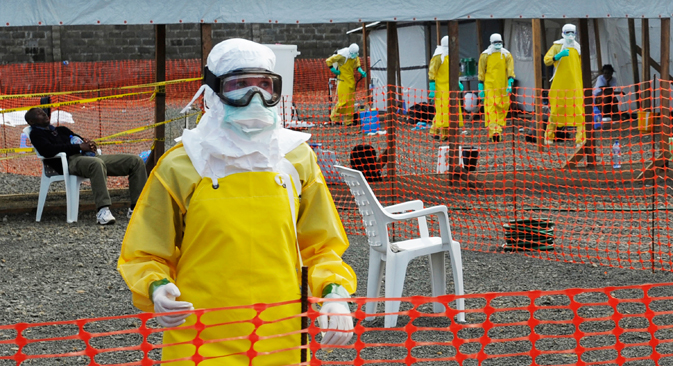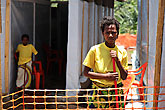Russian scientists develop experimental vaccine against Ebola virus

Medicins Sans Frontieres health workers prepare at ELWA's isolation camp during the visit of Senior United Nations System Coordinator for Ebola David Nabarro, at the camp in Monrovia August 23, 2014. As the outbreak has spread across borders from its initial epicentre in Guinea, governments in the region have introduced increasingly strict travel restrictions. Source: Reuters
An experimental vaccine against Ebola hemorrhagic fever developed by Russian scientists is undergoing pre-clinical animal testing and will soon be ready to be tested on humans, head of the Russian Federal Service for Consumer Rights' Protection Anna Popova has announced.
"There is every reason to expect that soon the vaccine could be used as a prevention against Ebola," she said, without however providing a specific timeframe.
A team of Russian epidemiologists and virologists are now working in Guinea, using a special mobile laboratory mounted on a Kamaz truck.
Russian experts are also working at the Donka Hospital in the Guinean capital city of Conakry, in close contact with the World Health Organization and Médecins Sans Frontières.
Latest figures
According to World Health Organization statistics as of Sept. 18, there are 5,347 people in West Africa infected with Ebola, and 2,618 people have already died of the disease. The average death rate is 60 percent, which is lower than in previous outbreaks, when mortality reached 90 percent.
Yet this outbreak could be considered the biggest since the virus was first detected in 1976. In addition to Guinea, Sierra Leone and Liberia, Ebola cases have been registered in Nigeria and Senegal.
According to an Oxford University study, the Ebola virus could spread to 15 tropical African countries, with nearly 22 million people living in the danger zone.
Another potential danger is that the virus may mutate and develop not only human-to-human but also airborne transmission, as predicted by Dr. Michael Osterholm, director of the Center for Infectious Disease Research and Policy at the University of Minnesota.
How to reduce the death rate?
A researcher with the Ivanovsky Institute of Virology in Moscow, Mikhail Shchelkanov, says that a vaccine, even an experimental one, can help tackle the virus, but what is far more important is to provide patients with proper care.
Related:
Russian specialists in Guinea take part in work on Ebola treatment recommendations
Russia working on Ebola vaccine
Rospotrebnadzor confirms absence of new suspected Ebola cases in Russia
Shchelkanov was among the first group of Russian virologists to go to Guinea in early August to help deal with the outbreak.
"If you provide a patient with the right palliative care, you will increase the patient's chance of survival by 10 percent. If you add the right disintoxication therapy, that cuts fatality by a further 10 percent. If you add respiratory support, you gain another 20 percent. If you add haemostatic therapy, that gives you a further 10 percent. If, on top of everything, you treat the patient with an antiserum, you gain 25-30 percent more," Shchelkanov says.
He points out that hemorrhagic fevers, like Ebola, are so dangerous because they develop very fast and occur in remote areas, where there are no hospitals and patients die before they are provided with care. With the right treatment in place, the death rate can be reduced to 5-10 percent.
"Take, for instance, Crimean-Congo hemorrhagic fever, which was very well-known in the USSR. In the absence of clear sanitary norms, in remote villages in Soviet-era Central Asia, it claimed the lives of every other patient," Shchelkanov says.
The price of failing to nip it in the bud
The main problem of the West African outbreak is that since it was not nipped in the bud in December 2013, when the first Ebola cases were reported, now, according to Shchelkanov, "it can be stopped only by deploying a military contingent there and separating villages from each other," although even that would not end the epidemic.
Even the 3,000 soldiers whom U.S. President Barack Obama dispatched to West Africa last week will only help to beef up cordons, Shchelkanov believes.
There are two fundamental reasons why it is very difficult to end the Ebola outbreak. First, as it is a zoonotic infection (one that is capable of being directly transmitted between animals and humans), it is practically impossible to control the circulation of the virus in the disease hotspots in the forests of Guinea, Sierra Leonie and Liberia. That would require data, to collect which an epidemiological station is needed, which Russia is now discussing with the Guinean authorities.
Second, West Africa is one of the poorest parts of the world, and there are practically no public health or epidemiological services in the modern sense of the word.
Poor public health is further exacerbated by administrative incompetence and rampant corruption, which does not make it possible to implement basic containment measures: An infected person can easily leave the cordoned area for a bribe of just $1.5.
Another thing that needs to be taken into account is the peculiarities of local religious practices. In particular, burials are conducted in the presence of the whole population of a village and it is usual to embrace the deceased before he or she is put in the grave. All this is not conducive to containing the outbreak.
More about the virus
The hotspots of the virus are located in forested areas in the hills of Upper Guinea. The natural hosts for the Ebola virus are fruit bats, which live in tropical forest. These creatures do not suffer from Ebola but transmit the virus via feces and saliva. Primates can get infected from the fruit bats. Large apes, made weak and lethargic by the disease, are an easy prey for hunters, thus spreading the virus to humans.
People can get infected from bats too. A well-cooked bat presents no danger, but people can get infected while preparing a bat for cooking.
The only way to beat the virus is to create a vaccine against it and carry out regular monitoring of hotspots.
Read more: Russian scientists visualize Ebola virus molecule:
Click to enlarge the infographics
All rights reserved by Rossiyskaya Gazeta.
Subscribe
to our newsletter!
Get the week's best stories straight to your inbox


